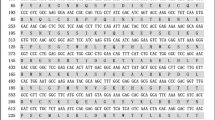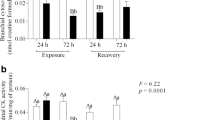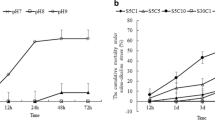Abstract
Cytoplasmic carbonic anhydrase (CAc) in the gill of teleost fish contributes to ionic regulation and acid–base balance by catalyzing the reversible reaction of CO2 and water, CO2 + H2O ↔ H+ + HCO3 −. Regulation of CAc abundance and activity therefore is expected to fine-tune responses to ionic or acid–base challenges. The present study investigated the potential for gill CAc of rainbow trout, Oncorhynchus mykiss (tCAc), to undergo reversible phosphorylation. The activity of tCAc was approximately doubled by phosphorylation achieved through in vitro stimulation of endogenous protein kinases; kinase stimulation doubled phospho-threonine content from that observed in tCAc isolated under conditions where both kinases and protein phosphatases were inhibited. In vitro incubation to preferentially stimulate specific kinases implicated protein kinase G (PKG) in mediating the increase in tCAc activity. The kinetic parameters of turnover number (k cat) and substrate affinity (K m) were similarly affected by stimulation of either kinase or phosphatase action. However, phosphorylation via kinase stimulation significantly increased the efficiency of tCAc (V max /K m), and this factor may have contributed to the elevation of tCAc activity. In addition, phosphorylation of tCAc by kinase stimulation significantly increased the inhibition constant (K i) for acetazolamide. These results demonstrate that tCAc is subject to reversible phosphorylation; future work should focus on identifying the physiological situation(s) in which phosphorylation of trout branchial CAc occurs.






Similar content being viewed by others
References
Bersimbaev RI, Konstantinov YM, Argutinskaya SV, Salganik RI (1975) The activation of rat gastric tissue carbonic anhydrase as a result of phosphorylation by 3′-5′-AMP-dependent protein kinase. Biokhimiia 40:570–577
Blom N, Gammeltoft S, Brunak S (1999) Sequence and structure-based prediction of eukaryotic protein phosphorylation sites. J Mol Biol 294:1351–1362
Boisen AMZ, Amstrup J, Novak I, Grosell M (2003) Sodium and chloride transport in soft water and hard water acclimated zebrafish (Danio rerio). Biochim Biophys Acta 1618:207–218
Boone CD, Pinard M, McKenna R, Silverman D (2014) Catalytic mechanism of α-class carbonic anhydrases: CO2 hydration and proton transfer. In: Frost SC, McKenna R (eds) Carbonic anhydrase: mechanism, regulation, links to disease, and industrial applications. Subcellular biochemistry v 75. Springer, Dordrecht, pp 31–52
Chang I-C, Hwang P-P (2004) Cl− uptake mechanism in freshwater-adapted tilapia (Oreochromis mossambicus). Physiol Biochem Zool 77:406–414
Chegwidden WR (1991) Purification of the carbonic anhydrases. In: Dodgson SJ, Tashian RE, Gros G, Carter N (eds) The carbonic anhydrases: cellular physiology and molecular genetics. Plenum Press, New York, pp 101–118
Church GA, Kimelberg HK, Sapirstein VS (1980) Stimulation of carbonic anhydrase activity and phosphorylation in primary astroglial cultures by norepinephrine. J Neurochem 34:873–879
Cohen P (2000) The regulation of protein function by multisite phosphorylation—a 25 year update. Trends Biochem Sci 25:596–601
Craig PM, Wood CM, McLelland GB (2007) Gill membrane remodeling with soft-water acclimation in zebrafish (Danio rerio). Physiol Genomics 30:53–60
Dieni CA, Storey KB (2010) Regulation of glucose-6-phosphate dehydrogenase by reversible phosphorylation in liver of a freeze tolerant frog. J Comp Physiol B 180:1133–1142
Ditte P, Dequiedt F, Svastova E, Hulikova A, Ohradanova-Repic A, Zatovicova M, Csaderova L, Kopacek J, Supuran CT, Pastoreková S, Pastorek J (2011) Phosphorylation of carbonic anhydrase IX controls its ability to mediate extracellular acidification in hypoxic tumors. Cancer Res 71:7558–7567
Esaki M, Hoshijima K, Kobayashi S, Fukuda H, Kawakami K, Hirose S (2007) Visualization in zebrafish larvae of Na+ uptake in mitochondria-rich cells whose differentiation is dependent on foxi3a. Am J Physiol 292:R470–R480
Esbaugh A, Lund SG, Tufts BL (2004) Comparative physiology and molecular analysis of carbonic anhydrase from the red blood cells of teleost fish. J Comp Physiol B 174:429–438
Esbaugh A, Perry SF, Bayaa M, Georgalis T, Nickerson JG, Tufts BL, Gilmour KM (2005) Cytoplasmic carbonic anhydrase isozymes in rainbow trout Oncorhynchus mykiss: comparative physiology and molecular evolution. J Exp Biol 208:1951–1961
Evans DH, Piermarini PM, Choe KP (2005) The multifunctional fish gill: dominant site of gas exchange, osmoregulation, acid-base regulation, and excretion of nitrogenous waste. Physiol Rev 85:97–177
Galvez F, Reid SD, Hawkings GS, Goss GG (2002) Isolation and characterization of mitochondria-rich cell types from the gill of freshwater rainbow trout. Am J Physiol 282:R658–R668
Georgalis T, Gilmour KM, Yorston J, Perry SF (2006a) The roles of cytosolic and membrane bound carbonic anhydrase in the renal control of acid-base balance in rainbow trout Oncorhynchus mykiss. Am J Physiol 291:F407–F421
Georgalis T, Perry SF, Gilmour KM (2006b) The role of branchial carbonic anhydrase in acid-base regulation in rainbow trout (Oncorhynchus mykiss). J Exp Biol 209:518–530
Gibbs MA, Kunze KL, Howald WN, Thummel KE (1999) Effect of inhibitor depletion on inhibitory potency: tight binding inhibition of CYP3A by clotrimazole. DMD 27:596–599
Gilmour KM (2012) New insights into the many functions of carbonic anhydrase in fish gills. Respir Physiol Neurobiol 184:223–230
Gilmour KM, Collier CL, Dey CJ, Perry SF (2011) Roles of cortisol and carbonic anhydrase in acid-base compensation in rainbow trout, Oncorhynchus mykiss. J Comp Physiol B 181:501–515
Gilmour KM, Perry SF (2009) Carbonic anhydrase and acid-base regulation in fish. J Exp Biol 212:1647–1661
Gilmour KM, Perry SF, Bernier NJ, Henry RP, Wood CM (2001) Extracellular carbonic anhydrase in dogfish, Squalus acanthias: a role in CO2 excretion. Physiol Biochem Zool 74:477–492
Gilmour KM, Randall DJ, Perry SF (1994) Acid-base disequilibrium in the arterial blood of rainbow trout. Respir Physiol 96:259–272
Goss GG, Adamia S, Galvez F (2001) Peanut lectin binds to a subpopulation of mitochondria-rich cells in the rainbow trout gill epithelium. Am J Physiol 281:R1718–R1725
Goss GG, Wood CM (1990) Na+ and Cl− uptake kinetics, diffusive effluxes and acidic equivalent fluxes across the gills of rainbow trout I. Responses to environmental hyperoxia. J Exp Biol 152:521–547
Henderson PJF (1973) Steady-state enzyme kinetics with high-affinity substrates or inhibitors. A statistical treatment of dose-response curves. Biochem J 135:101–107
Henry RP (1991) Techniques for measuring carbonic anhydrase activity in vitro: the electrometric delta pH and pH stat assays. In: Dodgson SJ, Tashian RE, Gros G, Carter ND (eds) The carbonic anhydrases: cellular physiology and molecular genetics. Plenum, New York, pp 119–126
Henry RP, Tufts BL, Boutilier RG (1993) The distribution of carbonic anhydrase type I and II isozymes in lamprey and trout: possible co-evolution with erythrocyte chloride/bicarbonate exchange. J Comp Physiol B 163:380–388
Hirata T, Kaneko T, Ono T, Nakazato T, Furukawa N, Hasegawa S, Wakabayashi S, Shigekawa M, Chang M-H, Romero MF, Hirose S (2003) Mechanism of acid adaptation of a fish living in a pH 3.5 lake. Am J Physiol 284:R1199–R1212
Innocenti A, Scozzafava A, Parkkila S, Puccetti L, De Simone G, Supuran CT (2008) Investigations of the esterase, phosphatase, and sulfatase activities of the cytosolic mammalian carbonic anhydrase isoforms I, II, and XIII with 4-nitrophenyl esters as substrates. Bioorg Med Chem Lett 18:2267–2271
Johnson KR, Olson KR (2008) Comparative physiology of the piscine natriuretic peptide system. Gen Comp Endocrinol 157:21–26
Kerstetter TH, Kirschner LB, Rafuse DD (1970) On the mechanisms of sodium ion transport by the irrigated gills of rainbow trout (Salmo gairdneri). J Gen Physiol 56:342–359
Kumai Y, Ward MAR, Perry SF (2012) β-Adrenergic regulation of Na+ uptake by larval zebrafish Danio rerio in acidic and ion-poor environments. Am J Physiol 303:R1031–R1041
Lindskog S, Silverman DN (2000) The catalytic mechanism of mammalian carbonic anhydrases. In: Chegwidden WR, Carter ND, Edwards YH (eds) The carbonic anhydrases: new horizons. Birkhäuser Verlag, Basel, pp 175–195
Lineweaver H, Burk D (1934) The determination of enzyme dissociation constants. J Am Chem Soc 56:658–666
Maetz J, Garcia-Romeu F (1964) The mechanism of sodium and chloride uptake by the gills of a fresh-water fish, Carassius auratus II. Evidence for NH4 + +/Na −and HCO3 −/Cl exchanges. J Gen Physiol 47:1209–1227
Maffia M, Rizzello A, Acierno R, Rollo M, Chiloiro R, Storelli C (2001) Carbonic anhydrase activity in tissues of the icefish Chionodraco hamatus and of the red-blooded teleosts Trematomus bernacchii and Anguilla anguilla. J Exp Biol 204:3983–3992
Maren TH, Friedland BR, Rittmaster RS (1980) Kinetic properties of primitive vertebrate carbonic anhydrases. Comp Biochem Physiol 67B:69–74
Maren TH, Wynns GC, Wistrand PJ (1993) Chemical properties of carbonic anhydrase IV, the membrane-bound enzyme. Mol Pharmacol 44:901
Marino S, Hayakawa K, Hatada K, Benfatto M, Rizzello A, Maffia M, Bubacco L (2007) Structural features that govern enzymatic activity in carbonic anhydrase from a low-temperature adapted fish, Chionodraco hamatus. Biophys J 93:2781–2790
Marshall WS, Grosell M (2006) Ion transport, osmoregulation, and acid-base balance. In: Evans DH, Claiborne JB (eds) The physiology of fishes, 3rd edn. CRC Press, Boca Raton, pp 177–230
McKenna R, Supuran CT (2014) Carbonic anhydrase inhibitors drug design. In: Frost SC, McKenna R (eds) Carbonic anhydrase: mechanism, regulation, links to disease, and industrial applications. Springer, Dordrecht, pp 291–323
Morrison JF (1969) Kinetics of the reversible inhibition of enzyme-catalysed reactions by tight-binding inhibitors. Biochim Biophys Acta 185:269–286
Narumi S, Miyamoto E (1974) Activation and phosphorylation of carbonic anhydrase by adenosine 3′,5′-monophosphate-dependent protein kinases. Biochim Biophys Acta 350:215–224
Olson KR, Donald JA, Dombkowski RA, Perry SF (2012) Evolutionary and comparative aspects of nitric oxide, carbon monoxide and hydrogen sulfide. Respir Physiol Neurobiol 184:117–129
Pastoreková S, Parkkila S, Pastorek J, Supuran CT (2004) Carbonic anhydrases: current state of the art, therapeutic applications and future prospects. J Enzyme Inhib Med Chem 19:199–229
Payan P, Matty AJ, Maetz J (1975) A study of the sodium pump in the perfused head preparation of the trout Salmo gairdneri in freshwater. J Comp Physiol 104:33–48
Perry SF, Gilmour KM, Bernier NJ, Wood CM (1999) Does gill boundary layer carbonic anhydrase contribute to carbon dioxide excretion: a comparison between dogfish (Squalus acanthias) and rainbow trout (Oncorhynchus mykiss). J Exp Biol 202:749–756
Perry SF, Laurent P (1990) The role of carbonic anhydrase in carbon dioxide excretion, acid-base balance and ionic regulation in aquatic gill breathers. In: Truchot J-P, Lahlou B (eds) Animal nutrition and transport processes 2. Transport, respiration and excretion: comparative and environmental aspects. Karger, Basel, pp 39–57
Perry SF, Malone S, Ewing D (1987) Hypercapnic acidosis in the rainbow trout (Salmo gairdneri) I. Branchial ionic fluxes and blood acid-base status. Can J Zool 65:888–895
Rizzello A, Ciardiello MA, Acierno R, Carratore V, Verri T, Di Prisco G, Storelli C, Maffia M (2007) Biochemical characterization of a S-glutathionylated carbonic anhydrase isolated from gills of the Antarctic icefish Chionodraco hamatus. Protein J 26:335–348
Ruppelt A, Oberprieler NG, Magklaras G, Taskén K (2010) Physiological substrates of PKA and PKG. In: Bradshaw RA, Dennis EA (eds) Handbook of cell signaling. Elsevier, Amsterdam, pp 1497–1514
Santovito G, Marino SM, Sattin G, Cappellini R, Bubacco L, Beltramini M (2012) Cloning and characterization of cytoplasmic carbonic anhydrase from gills of four Antarctic fish: insights into the evolution of fish carbonic anhydrase and cold adaptation. Polar Biol 35:1587–1600
Scott GR, Baker DW, Schulte PM, Wood CM (2008) Physiological and molecular mechanisms of osmoregulatory plasticity in killifish after seawater transfer. J Exp Biol 211:2450–2459
Scott GR, Claiborne JB, Edwards SL, Schulte PM, Wood CM (2005) Gene expression after freshwater transfer in gills and opercular epithelia of killifish: insight into divergent mechanisms of ion transport. J Exp Biol 208:2719–2729
Takei Y, Hirose S (2002) The natriuretic peptide system in eels: a key endocrine system for euryhalinity? Am J Physiol 282:R940–R951
Tanc M, Carta F, Scozzafava A, Supuran CT (2015) α-Carbonic anhydrases possess thioesterase activity. ACS Med Chem Lett 6:292–295
Tarrant MK, Cole PA (2009) The chemical biology of protein phosphorylation. Annu Rev Biochem 78:797–825
Tresguerres M, Katoh F, Orr E, Parks SK, Goss GG (2006) Chloride uptake and base secretion in freshwater fish: a transepithelial ion-transport metabolon? Physiol Biochem Zool 79:981–996
Whitney PL (1974) Affinity chromatography of carbonic anhydrase. Anal Biochem 57:467–476
Wood CM, Wheatly MG, Hõbe H (1984) The mechanisms of acid-base and ionoregulation in the freshwater rainbow trout during environmental hyperoxia and subsequent normoxia III. Branchial exchanges. Respir Physiol 55:175–192
Xiong ZJ, Storey KB (2012) Regulation of liver lactate dehydrogenase by reversible phosphorylation in response to anoxia in a freshwater turtle. Comp Biochem Physiol B 163:221–228
Zinke M, Hanff E, Böhmer A, Supuran CT, Tsikas D (2015) Discovery and microassay of a nitrite-dependent carbonic anhydrase activity by stable-isotope dilution gas chromatography-mass spectrometry. Amino Acids. doi:10.1007/s00726-015-2081-3
Acknowledgments
This work was supported by NSERC of Canada Discovery and Research Tools and Instruments grants to KMG. DC was supported by an NSERC postgraduate scholarship and an Ontario graduate scholarship. Thanks are extended to Bill Fletcher and Christine Archer for their excellent care of the trout in the aquatic facility.
Author information
Authors and Affiliations
Corresponding author
Additional information
Communicated by H.V. Carey.
Electronic supplementary material
Below is the link to the electronic supplementary material.
Rights and permissions
About this article
Cite this article
Carrie, D., Gilmour, K.M. Phosphorylation increases the catalytic activity of rainbow trout gill cytosolic carbonic anhydrase. J Comp Physiol B 186, 111–122 (2016). https://doi.org/10.1007/s00360-015-0942-4
Received:
Revised:
Accepted:
Published:
Issue Date:
DOI: https://doi.org/10.1007/s00360-015-0942-4




